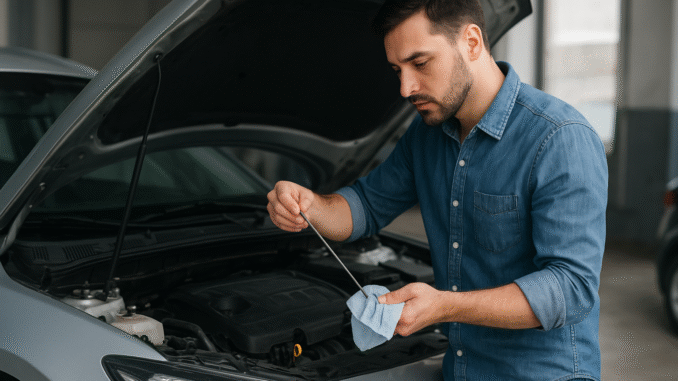
How to Keep Your Car Running Smoothly: Essential Maintenance Tips for Every Driver
Owning a car brings freedom, convenience, and pride. But keeping it in great condition requires consistent care and attention. A well-maintained vehicle not only performs better but also lasts longer, saves fuel, and helps you avoid costly repairs in the future. Whether you’re a new driver or a seasoned car owner, understanding basic car maintenance can make a huge difference.
In this guide, we’ll explore essential maintenance tips every driver should follow to keep their car running smoothly, efficiently, and safely.
1. Follow a Regular Maintenance Schedule
Every vehicle comes with a manufacturer’s recommended maintenance schedule, often found in the owner’s manual. This guide outlines when to perform services such as oil changes, tire rotations, brake inspections, and fluid replacements.
Neglecting these scheduled services can lead to performance issues or even major engine damage. If you’re unsure about the schedule, most modern vehicles also provide reminders through dashboard alerts or mobile apps.
Pro Tip: Stick to your maintenance schedule strictly — even minor delays in oil or filter changes can cause long-term problems.
2. Check and Change Your Engine Oil Regularly
The engine oil is the lifeblood of your car. It lubricates moving parts, reduces friction, and helps keep the engine cool. Over time, oil breaks down and becomes contaminated with dust and debris, which can cause wear and tear on engine components.
- How often to change: Every 5,000 to 7,500 miles for most cars, but always check your owner’s manual.
- Signs you need a change: Dark or dirty oil, engine knocking sounds, or the oil change light appearing on your dashboard.
Pro Tip: Use the oil grade recommended by your manufacturer. High-quality synthetic oils can also improve performance and extend engine life.
3. Keep an Eye on Fluid Levels
Your car relies on several fluids besides engine oil. Each plays a crucial role in keeping your vehicle operating smoothly. Make sure to check and top up these fluids regularly:
- Coolant (Antifreeze): Prevents overheating and keeps your engine at the right temperature.
- Brake Fluid: Essential for responsive and safe braking.
- Transmission Fluid: Keeps gear shifts smooth.
- Power Steering Fluid: Ensures easy steering control.
- Windshield Washer Fluid: Keeps your windshield clean for better visibility.
Pro Tip: Check fluid levels at least once a month and before long road trips. If you notice any leaks under your car, get them checked immediately.
4. Inspect and Replace Air Filters
Your car’s air filter prevents dirt, dust, and debris from entering the engine. Over time, it gets clogged, reducing airflow and fuel efficiency.
A dirty air filter can cause sluggish acceleration and lower gas mileage. Most experts recommend replacing it every 12,000 to 15,000 miles, but it depends on your driving environment — dusty areas may require more frequent changes.
Pro Tip: Check the air filter every time you change your oil. A clean filter helps your engine “breathe” better and improves performance.
5. Monitor Tire Pressure and Tread
Your tires are the only part of your car that touches the road, so maintaining them is vital for safety and performance.
- Tire Pressure: Under-inflated tires cause poor fuel economy, while over-inflated tires can wear unevenly.
- Tread Depth: Worn-out tires can be dangerous, especially on wet or slippery roads.
You can use a tire pressure gauge to check pressure levels (usually recommended on a sticker inside the driver’s door or in your manual).
Pro Tip: Check your tire pressure at least once a month and before long trips. Rotate your tires every 6,000 to 8,000 miles to ensure even wear.
6. Check and Maintain Your Battery
Car batteries typically last 3 to 5 years, but their lifespan depends on usage and weather conditions. Cold or hot climates can shorten battery life, so regular checks are essential.
Look for signs like dim headlights, slow engine cranking, or corrosion on battery terminals. Keeping the terminals clean and tight ensures a strong electrical connection.
Pro Tip: Test your battery voltage at least twice a year — especially before winter — and replace it promptly if it’s weak.
7. Don’t Ignore Brake Maintenance
Brakes are arguably the most critical safety system in your vehicle. Pay close attention to any signs of brake issues, such as:
- Squealing or grinding noises
- A vibrating brake pedal
- Longer stopping distances
These symptoms may indicate worn brake pads or low brake fluid levels. Ignoring them can cause damage to your brake rotors or lead to accidents.
Pro Tip: Have your brakes inspected at least once a year or every 12,000 miles. Always replace brake pads before they become too thin.
8. Replace Wiper Blades and Keep Your Windshield Clean
Visibility is crucial for safe driving, especially during rain or storms. Wiper blades wear out over time and can leave streaks or fail to clear water effectively.
Replace your wiper blades every 6 to 12 months, depending on weather conditions. Also, keep your windshield clean both inside and out for maximum clarity.
Pro Tip: Use a high-quality windshield washer fluid that can handle dirt, bugs, and light frost.
9. Pay Attention to Warning Lights
Modern cars are equipped with diagnostic systems that alert drivers to potential issues through dashboard warning lights. Common ones include:
- Check Engine Light
- Battery Warning Light
- Oil Pressure Light
- Brake System Light
Ignoring these lights can lead to serious damage or safety hazards. When a warning appears, check your manual for the meaning and consult a mechanic if needed.
Pro Tip: A simple OBD-II scanner can help you read diagnostic codes at home and understand what’s going on before visiting a repair shop.
10. Maintain Proper Wheel Alignment and Suspension
Proper wheel alignment ensures your tires wear evenly and your car handles smoothly. If you notice your steering pulling to one side or uneven tire wear, your alignment might be off.
Similarly, suspension components like shocks and struts help absorb road impacts. If your car feels bouncy or unstable, it might be time for a suspension check.
Pro Tip: Have your alignment checked at least once a year or whenever you install new tires.
11. Keep Your Car Clean — Inside and Out
Regular washing and detailing aren’t just about looks — they help preserve your vehicle’s paint, prevent rust, and maintain resale value. Dirt, salt, and pollution can eat away at your car’s finish over time.
Vacuuming and cleaning the interior also prevent buildup of dust, bacteria, and odors, creating a healthier and more enjoyable driving environment.
Pro Tip: Wax your car every few months to protect the paint and give it a glossy shine.
12. Listen, Feel, and Smell for Changes
Your car communicates through subtle signals. Unusual noises, vibrations, or smells can indicate potential problems.
- Grinding or squealing: May signal brake or bearing issues.
- Burning smell: Could mean an oil leak or electrical problem.
- Rough idling or shaking: Might suggest engine trouble.
Pro Tip: Don’t ignore small changes. Early detection often prevents expensive repairs later.
13. Drive Smoothly and Responsibly
Your driving habits have a major impact on your car’s longevity. Aggressive acceleration, sudden braking, and speeding can wear out components faster.
Smooth driving conserves fuel, reduces stress on the engine and transmission, and enhances overall vehicle health.
Pro Tip: Warm up your car for a few minutes before driving, especially in cold weather, to allow the engine oil to circulate properly.
14. Prepare for Seasonal Changes
Different seasons demand different car care routines.
- In winter, check your battery, antifreeze, and tire traction.
- In summer, ensure the cooling system and air conditioning are in good shape.
Pro Tip: Always keep an emergency kit in your car, including jumper cables, a flashlight, first-aid supplies, and basic tools.
The Long-Term Benefits of Regular Maintenance
Taking care of your car is an investment that pays off in many ways:
- Better performance and reliability
- Higher resale value
- Fewer costly repairs
- Improved safety for you and your passengers
Ultimately, routine maintenance is about preventing problems before they happen. It’s far cheaper and easier to replace oil or filters than to fix a broken engine.
Final Thoughts
Your car is more than just a machine — it’s your daily companion on the road. By following these essential maintenance tips, you’ll ensure it runs smoothly for years to come. Consistent care, attention to detail, and responsible driving go a long way toward keeping your vehicle in peak condition.
So next time you hit the road, you can drive with confidence knowing your car is well cared for — efficient, safe, and ready for any journey ahead.

